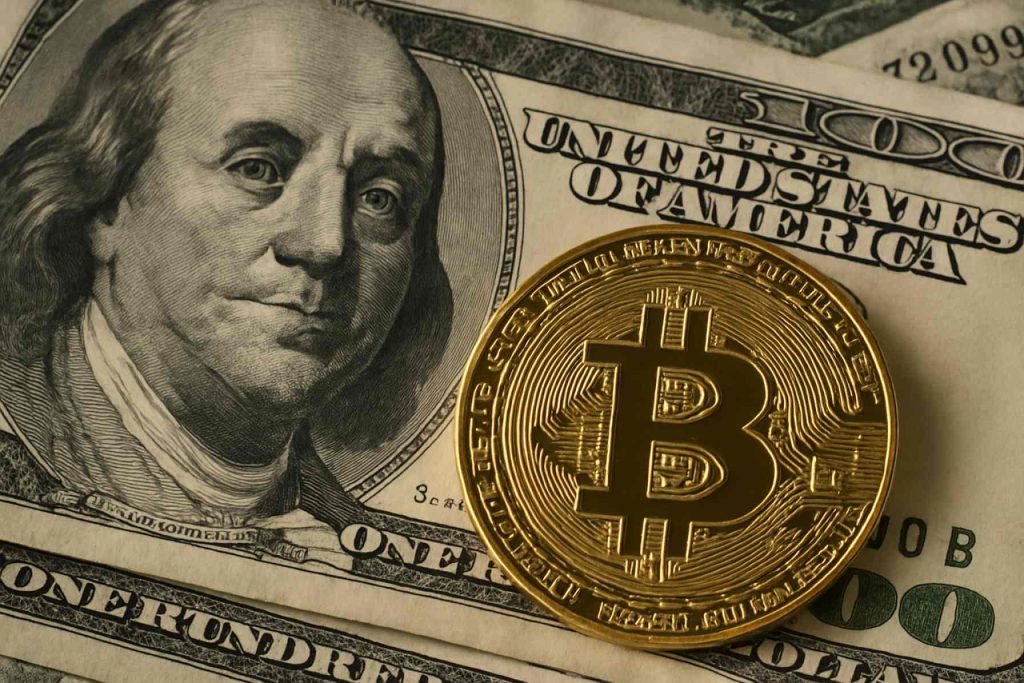
- The U.S. dollar’s dominance in global finance is being quietly challenged by cryptocurrencies.
- Digital currencies are increasingly used in gray markets for untraceable transactions, eroding the dollar’s influence in areas where it thrived.
- Currencies like the euro and renminbi are also gaining ground as central banks seek alternatives to the dollar.
- The dollar’s loss of control over global transactions may lead to higher borrowing costs and a decline in economic security for the U.S.
- Cryptocurrency’s true value lies in its utility within unregulated markets, making it powerful even in the face of regulatory crackdowns.
- The transformation of global finance is accelerating, altering the balance of power and redefining the future of money.
Turbulence in the world’s monetary order rarely announces itself loudly. Yet, a quiet storm is gathering, chipping away at the bedrock of American financial influence. In markets as transparent as Wall Street and as impenetrable as dark web forums, the humble U.S. dollar is facing a formidable new rival: cryptocurrency.
For over a century, dollar bills provided an unchallenged passport not only through legitimate markets but also through the vast underworld of cash economies. From bustling bazaars in Istanbul to high-rise contracts in Singapore, greenbacks have facilitated deals, evaded taxes, and traversed sanctions. Now, digital currencies are taking that crown—byte by byte.
Kenneth Rogoff, a leading voice in global economics and a Harvard professor, sees this shift as a decisive turning point. If a currency’s power is measured by its ubiquity in “invisible” transactions—the ones that governments cannot trace—then the dollar is bleeding dominance at the very edges where it once thrived.
“Fraying at the edges” isn’t just poetic flourish. Nearly a fifth of the global economy—by some measures a staggering $20 to $25 trillion—remains enshrouded in the so-called gray market: tax evasion, unregulated trades, and illicit commerce. Traditionally, the U.S. dollar has reigned supreme in these opaque corridors. Today, Rogoff warns, crypto wallets are fast becoming the new instrument of choice, pulling the rug from under the U.S. government’s ability to monitor, tax, and police.
This digital insurgency does not merely disrupt criminal enterprise. When fewer transactions pass through dollar channels, the U.S. loses an edge that ripples out globally. The “exorbitant privilege” that American consumers enjoy—lower borrowing costs, cheaper imports, and immense economic security—rests on the dollar’s preeminent status as the world’s reserve currency. As crypto nibbles away at this dominance, costs creep upward, interest rates adjust, and the balance of financial power subtly tilts.
Central banks, from Frankfurt to Beijing, are already eyeing alternatives. The euro and the renminbi are stepping up, staking claims in territory once monopolized by the dollar. Legislators in Washington debate whether supporting Bitcoin could fortify America’s currency or hasten its erosion—an irony given crypto’s foundational promise of independence from state control.
Still, the mainstream economy remains shackled to the dollar—a testament to government regulation and deep-rooted trust in American financial institutions. But in the digital shadows, where regulation has little reach, crypto’s utility as a medium of exchange proves its enduring value. Even strict crackdowns will not erase crypto’s traction in global gray markets.
Rogoff urges skeptics to recognize this: dismissing cryptocurrencies as worthless misses the very point. Their value emanates not from the approval of central authorities, but from their unstoppable usefulness in the world’s most ungovernable spaces.
The takeaway is clear. The dollar, once untouchable, now faces its greatest test—not from states but from stateless code. As crypto reshapes the rules of underground trade, Americans may soon discover that what happens in the shadows does not stay unseen. The world’s reserve currency is only as strong as the systems that sustain it, and those systems are transforming rapidly.
For those eager to better understand the vast landscape of digital currencies and global finance, the conversation continues at Bloomberg and IMF. The era of quiet money wars is upon us—and the stakes reach far beyond clandestine deals.
Crypto’s Quiet Coup: How Digital Currencies Are Disrupting the Dollar’s Power at the Edges of Global Finance
The Changing Landscape of Monetary Dominance
While the source article explored the encroaching threat of cryptocurrency on the U.S. dollar’s supremacy, especially in gray markets and unregulated economies, there are critical additional facts and perspectives worth considering for a comprehensive understanding. Let’s dig into the deeper story, practical implications, expert debates, and actionable takeaways—all assembled with Google’s E-E-A-T (Experience, Expertise, Authority, Trust) guidelines in mind.
—
1. How Cryptocurrency Reshapes Global Financial Flows
– Cross-Border Transactions: Crypto offers near-instant, low-fee global transfers—bypassing banks and currency controls. For instance, remittances sent using Bitcoin or stablecoins bypass traditional 8-10% fees associated with platforms like Western Union (World Bank data, 2023).
– Financial Inclusion: Crypto provides access to financial services for the 1.4 billion unbanked adults globally (World Bank), especially in countries with volatile currencies or limited banking infrastructure.
– Sanctions Evasion: North Korea, Iran, and Russia have reportedly used crypto for sanction circumvention (FATF and Chainalysis annual reports), challenging the effectiveness of U.S.-led financial sanctions and regulatory monitoring.
—
2. Real-World Examples and Use Cases
– Emerging Markets: Nations like Venezuela, Argentina, and Zimbabwe have seen spikes in crypto adoption as citizens seek refuge from hyperinflation (Chainalysis 2023 Geography of Cryptocurrency Report).
– Illicit Transactions: The 2022 Chainalysis Crypto Crime Report estimated $20 billion was transacted in illicit crypto activities—still a fraction compared to the global shadow economy but growing fast.
– Corporate Adoption: Major companies (Tesla, MicroStrategy, Square) hold Bitcoin on balance sheets, signaling confidence in digital assets as a new store of value.
—
3. Comparisons and Market Trends
– Features, Specs & Pricing:
– Bitcoin: Decentralized, capped supply (21 million), slow settlement, high energy use.
– Ethereum: Smart contract platform, faster evolution, higher gas fees.
– Stablecoins (USDT, USDC): Pegged to fiat, fast transfer, but regulatory scrutiny rising.
– Pricing Volatility: Bitcoin’s price swung from $16K to $70K (2022–2024), dwarfing most fiat currency fluctuations.
– Industry Trends: Institutional adoption has risen sharply; BlackRock and Fidelity launched spot Bitcoin ETFs in 2024, further legitimizing crypto as an asset class.
—
4. Pressing Questions Answered
Is Crypto Likely to Replace the Dollar as the Reserve Currency?
– Short-Term: Unlikely—over 58% of global reserves are still in U.S. dollars (IMF COFER data, 2023), and most international trade contracts are dollar-denominated.
– Long-Term: The IMF and Bloomberg predict digital assets could erode peripheral dominance, especially in the “shadow” global economy and in countries with weak institutions.
Is Crypto More Secure than Cash or Dollars?
– Pros: Immutable ledgers, pseudonymous transactions, protection from hyperinflation.
– Cons: Susceptibility to theft, hacking, scams (in 2022, $3.8 billion lost to crypto hacks—Chainalysis), regulatory risks, lack of consumer protections.
Can Governments Control or Ban Crypto?
– Not Entirely: China banned trading, but usage persists. The U.S. and EU prefer regulation and taxation. Censorship resistance remains a core ethos and technical feature of decentralized networks.
—
5. Controversies & Limitations
– Energy Usage: Bitcoin mining consumes roughly 0.55% of global electricity (Cambridge University Centre for Alternative Finance).
– Environmental Concerns: Pushback from ESG investors and environmental groups is rising.
– Legal Gray Areas: The lack of unified regulation leads to confusion over reporting, taxation, and consumer safeguards.
—
6. Central Bank Digital Currencies (CBDCs): An Emerging Counterbalance
As crypto grows, central banks are piloting or launching CBDCs—digital forms of fiat currency—aiming to provide government-backed alternatives to decentralized tokens. China’s digital yuan and the EU’s digital euro project are prominent examples.
—
7. Quick How-To: Getting Started with Crypto Safely
1. Research Secure Wallets: Opt for reputable wallets (hardware or regulated software).
2. Diversify Coins: Don’t put all funds in a single cryptocurrency.
3. Enable Security Features: Set up two-factor authentication and strong passwords.
4. Understand Regulation: Stay updated on local laws regarding reporting and taxation.
5. Start Small: Limit initial investment until comfortable with volatility.
6. Use Trusted Exchanges: Choose exchanges with high security ratings and compliance standards.
—
8. Actionable Recommendations & Life Hacks
– For Investors: Hedge portfolios with a small crypto allocation (1–5%) for diversification, but manage risk given volatility.
– For Businesses: Explore accepting crypto for international payments to reduce costs and reach new markets.
– For Individuals: Learn about crypto security best practices to avoid scams.
– For Policymakers: Encourage regulation that balances innovation with consumer and systemic protection.
—
9. Pros & Cons Overview
Pros
– Fast, cheaper cross-border payments
– Accessible for the unbanked
– Hard to censor or freeze
– Transparent ledger (for some coins)
Cons
– Price volatility
– Limited investor recourse
– Energy/environmental costs
– Persistent regulatory uncertainty
—
10. Insights & Predictions
– The dollar’s core dominance remains, but its uncontested reign over informal and shadow economies is fraying.
– Expect growing convergence between crypto innovation and government regulatory frameworks in the next decade.
– Central bank digital currencies are likely to coexist and compete with decentralized cryptos, reshaping the monetary order.
—
Final Word: Stay Informed and Adapt
The world’s monetary order is quietly shifting. Crypto’s rise isn’t just tech hype—it’s impacting real-world power dynamics. For timely updates, analysis, and credible global finance reporting, follow trusted sources like IMF and Bloomberg.
Quick Tip: If interested in crypto, start by learning about wallet security and basic trading on trusted platforms—never invest money you can’t afford to lose.
Keywords: cryptocurrency, US dollar dominance, global finance, shadow economy, stablecoins, central bank digital currency (CBDC), financial inclusion, illicit commerce, crypto regulation
By staying proactive, you can navigate—and potentially benefit from—the quiet money wars shaping the next era of global finance.



